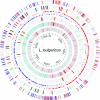The complete genome sequence of Lactobacillus bulgaricus reveals extensive and ongoing reductive evolution
- PMID: 16754859
- PMCID: PMC1482600
- DOI: 10.1073/pnas.0603024103
The complete genome sequence of Lactobacillus bulgaricus reveals extensive and ongoing reductive evolution
Abstract
Lactobacillus delbrueckii ssp. bulgaricus (L. bulgaricus) is a representative of the group of lactic acid-producing bacteria, mainly known for its worldwide application in yogurt production. The genome sequence of this bacterium has been determined and shows the signs of ongoing specialization, with a substantial number of pseudogenes and incomplete metabolic pathways and relatively few regulatory functions. Several unique features of the L. bulgaricus genome support the hypothesis that the genome is in a phase of rapid evolution. (i) Exceptionally high numbers of rRNA and tRNA genes with regard to genome size may indicate that the L. bulgaricus genome has known a recent phase of important size reduction, in agreement with the observed high frequency of gene inactivation and elimination; (ii) a much higher GC content at codon position 3 than expected on the basis of the overall GC content suggests that the composition of the genome is evolving toward a higher GC content; and (iii) the presence of a 47.5-kbp inverted repeat in the replication termination region, an extremely rare feature in bacterial genomes, may be interpreted as a transient stage in genome evolution. The results indicate the adaptation of L. bulgaricus from a plant-associated habitat to the stable protein and lactose-rich milk environment through the loss of superfluous functions and protocooperation with Streptococcus thermophilus.
Conflict of interest statement
Conflict of interest statement: No conflicts declared.
Figures




References
-
- Heller K. J. Am. J. Clin. Nutr. 2001;73:374S–379S. - PubMed
-
- Metchnikoff E. The Prolongation of Life. London: Heinemann; 1907.
-
- Mercenier A., Pavan S., Pot B. Curr. Pharm. Des. 2003;9:175–191. - PubMed
-
- Adolfsson O., Meydani S. N., Russell R. M. Am. J. Clin. Nutr. 2004;80:245–256. - PubMed
-
- Perdigon G., Maldonado Galdeano C., Valdez J. C., Medici M. Eur. J. Clin. Nutr. 2002;56(Suppl. 4):S21–S26. - PubMed
Publication types
MeSH terms
Substances
LinkOut - more resources
Full Text Sources
Other Literature Sources
Molecular Biology Databases
Miscellaneous

